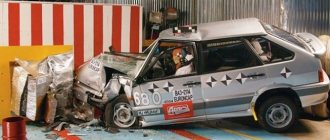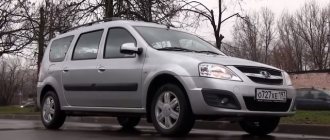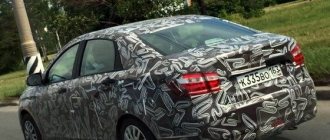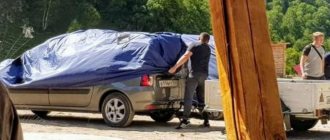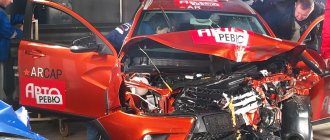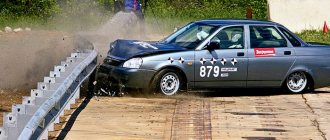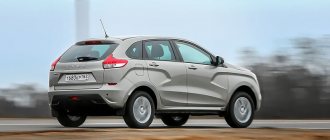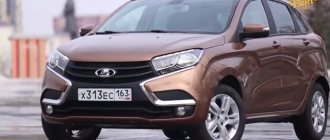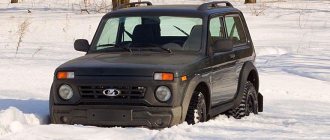In 2008, AvtoVAZ reached an agreement with Renault to acquire the rights to produce and sell under its own brand models built using the platforms: “R90”, “F90” and “B0”. Along with this, the domestic auto giant acquired the rights to assemble 1.4 and 1.6-liter power plants developed in Renault.
As a result of effective cooperation, the universal model Lada Largus was born, which is a joint product of AvtoVAZ and Renault-Nissan. In terms of its exterior, this car is similar to the best-selling Dacia Logan MCV, which has been on the assembly line since 2006.
With the release of the Lada Largus model, it quickly acquired a wide audience of fans. However, as the car was in use, it began to acquire not only positive aspects. The “losing” features of the design also became apparent.
For those buyers who are seriously attracted to the Russian station wagon, a crash test will be a good help, which is what our further story will be about. It will allow not only to identify the advantages, but also to identify the disadvantages of the popular station wagon. We also suggest watching the video of the test.
Lada Largus - home station wagon
Lada Largus is a very affordable home station wagon, which is a licensed version of the Dacia Logan MCV, produced in 2006. Almost all car enthusiasts will like this car. The most common configuration has an eight-valve 1.6 engine (84 hp), one safety pad and even audio preparation. As for the richest configuration of Largus, it is already a seven-seater car, stuffed with an abundance of functions. Most often, the luxury package includes such functions as heated mirrors, an alarm system with auto start, fog lights and almost everything else.
The new Lada Largus passed the crash test
The results of the crash test of the Lada Largus were noted very worthy by Autoreview. Like any square, Largus has its drawbacks. But be that as it may, this car, in the opinion of observers of the Autoreview auto portal, does not have shortcomings, but some “zest”, which may not seem like a flaw to almost everyone.
About security
Lada Largus has become popular among motorists. Not the least role in this was played by numerous borrowings of ideas used on the French station wagon, produced until 2006. In the minimum configuration, as well as in the “norm” version, in addition to audio preparation and a standard 4-cylinder engine, the manufacturer offered one front airbag for the driver, which was not bad at that time.
In the maximum configuration there is a cabin with 5 seats (if necessary, it can be increased to 7 seats) with a large number of additions, many of which increase the safety of the car.
As for the materials used in production, they are standard for modern automotive industry. Their quality, traditionally for domestic manufacturers, is not the highest in order to reduce the cost. Many motorists, especially the old generation, complain that previously the metal of the body was much thicker, which is why cars lasted a long time. For example, on GAZ cars (the legendary Volga) the thickness was up to two millimeters, but now it rarely reaches one millimeter even on the bottom. For example, on Largus the bottom is 0.9 mm, and the body parts are from 0.6 to 0.8 mm.
The modern generation may assume that this was done to reduce the weight of the car: adding lighter and stronger materials instead of heavy metal. On foreign cars, especially class C and higher, this may be the case. But this does not apply to the budget class, to which Largus belongs. Therefore, there is no need to talk about the safety of the materials used by the manufacturer. But, on the other hand, car owners are ready to neglect safety by getting a cheaper and more practical car for everyday life.
Still, Largus, despite its low cost, boasts high-quality steel, which makes up the strength structure of the body elements and thereby ensures passive safety. Body panels and plastic (soft or hard) do not affect safety in any way. All this is primarily created for beauty and serves to give a certain individual style.
Revealed helplessness of Lada Largus
Like any car, the Lada Largus crash test was carried out in an indispensable manner. In such tests, compliance with the standards of the Rules is revealed: UNECE No. 95-02 - side impact, UNECE No. 94-01, which determines compliance with a frontal collision, and UNECE No. 34-02 - collision with a movable barrier from the rear side of the vehicle. A total of three surveys make it possible to understand the suitability of this transport.
Crash test Lada Largus No. 1:
During a side study, a special cart crashes into the car at a speed of 50 km/h. The Lada Largus passed this crash test with complete dignity. Due to the damage acquired, the car doors did not open. The mannequin, which was in the car at the time of the inspection, received damage to its head that was 8 times lower than what is permissible according to the rules. Speaking of pelvic injuries, here too Largus coped with his task, meeting the requirements threefold.
As for damage to a car after a collision with it from behind, Largus is not a loser here either, because it unsurpassedly protects passengers from unnecessary injuries. After a collision with a moving barrier at a speed of 36 km/h, the interior remained intact, keeping the seats in place. What is also distinctive is that the glass of the side doors, as well as the glass of the luggage compartment door, remained undamaged. The fuel tank is unrivaledly protected by a spare wheel and suspension components. This is confirmed by the fact that the fuel tank remained intact during the collision.
Crash test Lada Largus No. 2:
The Largus crash test confirmed that the car meets all legitimate safety requirements. Tests were carried out under the most stringent criteria. If, according to the established rules, a front collision must occur at a speed of 56 km/h, then here the speed used was 8 km/h higher, i.e. 64km/h.
According to the test, the car received 8.32 points out of a possible 10, and this is a very good result that can be compared with the Dacia Logan MCV, which received 8 points in 2005. This means that you can receive this punishment and not be afraid.
Source: larguscenter.ru
Crash test Lada Largus
In 2008, AvtoVAZ reached an agreement with Renault to acquire the rights to create and sell under its brand models built using the platforms: “R90”, “F90” and “B0”. Along with this, the Russian auto giant acquired the rights to assemble 1.4 and 1.6-liter power plants developed in Renault.
As a result of effective cooperation, the versatile Lada Largus model was born, which is a joint product of AvtoVAZ and Renault-Nissan. In terms of its exterior, this car is identical to the blockbuster Dacia Logan MCV, which has been on the production line since 2006.
With the release of the Lada Largus model, it quickly acquired a wide audience of fans. But as the car was in operation, it began to “overgrow” with not only positive qualities. The “losing” individualities of the design also emerged.
For those buyers who seriously liked the Russian station wagon, a crash test will be a good assistant, which is what our upcoming story will be about. It will allow you not only to identify the advantages, but also to identify the shortcomings of the popular station wagon. We also suggest watching the video test.
Laconic review of the Lada Largus car
The car is positioned as a family vehicle that can arouse enthusiasm among almost all comfortable owners. The driving force is an 8-valve engine with a volume of 1.6 liters. It is capable of producing 84 HP. pp., which is completely sufficient for city traffic. The station wagon's interior is equipped with a driver's airbag and a modern audio complex.
The most stuffed version of the all-purpose Lada Largus has a seven-seater cabin and a wide range of auxiliary equipment for convenience. Here you can find:
- option for heated exterior mirrors;
- anti-fog optics;
- security system with auto start function.
Attention! When the crash test was carried out, the Lada Largus station wagon showed fairly decent results. Let’s say right away that there were also disadvantages, which is typical of any other model.
Teremok
The interior is a copy of the first-generation Logan interior. With the difference that a VAZ boat “floated” onto the hub of the three-spoke steering wheel, the Largus Cross inscription appears on the sills, and original finishing materials were used. The station wagon especially suits the light gray leatherette inserts in the door panels, and the silver plastic decor on the front panel enlivens the generally conservative atmosphere. Want even more emotions? You can order an interior with orange decorative elements - it looks catchy and fresh.
You need to get used to the ergonomics of the driver's seat - there are many layout solutions implemented by French engineers. For example, the horn signal is located at the end of the steering column switch, the rear window buttons are located on the transmission tunnel, and in order to adjust the driver’s seat in height, you should press the lever at its left end and stand up slightly. In fact, the unusual architecture and settings algorithm are not difficult to adapt to. In addition, they say that after restyling, the Largus family will acquire a steering wheel with multifunction keys and a classic sound signal in the hub.
And finally, practicality is the most important component of Largus Cross. Like the regular Largus, the raised station wagon is available in five- and seven-seater versions. In the first case, you get a huge luggage compartment (560 l) with excellent ergonomics. In the configuration for seven (as in the test car), the volume of the luggage compartment is no longer exciting (135 liters), and there is no luggage curtain. However, the third row seats can be folded or completely dismantled, then the family station wagon will turn into something like a delivery “heel”.
Crash test of Lada Largus
The test scenario for the Lada Largus Cross, which was carried out at AvtoVAZ’s testing site, involved several steps:
- A forward collision involving a 40-degree offset in the direction of impact. By doing this, the test participants sought to imitate the effect of the forward movement that occurs on the oncoming lane of the highway.
- A side impact, which can often be observed in reality when a car collides with a pole.
- Hit to the rear. Here the car standing behind appeared as an obstacle.
The progress of this test complied with the regulatory nuances outlined in the “Uniform Guidelines from the UNECE”. The entire list of standards is indicated in Fri: No. 94, No. 95 and No. 34.
Compared to the testing requirements according to the NCAP system used by European manufacturers, this regulation differs in the most “soft” standards. For example, the procedure for simulating a frontal collision in Europe implies a preliminary achievement of a speed of 64 km per hour, but in the AvtoVAZ testing criteria this speed is only 56 km per hour.
Attention! For the next sale of the Lada Largus on the Russian market, these crash tests are completely sufficient. To gain access to the European markets, you will need to do the entire list of tests again, while adhering to the requirements of the NCAP standard.
Interior
The new station wagon has been updated with little, not only on the outside, but also on the inside. First of all, the interior of the car has been transformed in terms of design, but the functionality and service elements have remained largely untouched. The most noticeable thing here was the introduction of orange elements into the interior of the doors, front panel and seats, by the way, made of high-quality leather.
The upholstery of all seats is clearly highlighted with orange stitching. On the thresholds you can see the inscription “Largus Cross” appearing. The steering wheel, unfortunately, has undergone certain changes, causing mixed feelings about the ease of use. In addition, the sound signal remained under the steering wheel.
The presence of buttons and switches is reduced to the required minimum. Those that are available remain in the same places as in the basic version of Largus. The steering wheel does not have multifunction, behind it there are information sensors: speedometer, chronometer and reminder indicators.
On the right is a modern radio built in the middle with standard functions: CD, USB, AUX, Bluetooth and radio. Below this are service keys and a control unit for the stove and air conditioner, which are already present in the database. The high gear lever and parking brake lever are installed even closer to the driver's hand.
The “station wagon” is provided with a full power package, although driving it causes inconvenience. Surprisingly, transmission control was not added, because in the station wagon only the front axle remained driven.
Of course, this arrangement of options controls takes some getting used to. But, despite the various nuances, sitting in the cabin of the Lada Largus Cross you feel very comfortable, and this applies not only to the front row, but also to the second, and if there is one, then passengers in the third row will not feel confined. Moreover, you can notice that even the basic version already has an Airbag that protects the people sitting in front.
Such arrangements can be disappointing. After all, in fact, VAZ introduced only fairly minor changes. But you shouldn’t write off this model just for this reason. The list of shortcomings in ergonomics is not so long, but was largely inherited from platform models.
Looking at the photo of the Lada Largus interior, you understand that perfection is still far away, however, the interior does not look so wooden. The level of comfort is ensured by the front profiled seats, which have received noticeable lateral support and a heating function. The driver's seat itself can be adjusted in height and lumbar support.
Three tall passengers can easily sit on the rear sofa, and they will not feel discomfort in the head or legs. There is enough free usable space. In the seven-seater version of the Lada Largus Cross 7, in the aft there is another sofa with a couple of seats.
In the stern there is another sofa with a couple of seats
You can sit in the “gallery” without any particular difficulties, and there will be enough space, so there will be no embarrassment. The developers did a good job on the functionality of the interior, so they managed to equip the interior with various unique elements. The shoulder area now features attractive orange leather inserts. Largus Cross 2022, a new model, will undoubtedly be able to please motorists with its thoughtful functionality.
Although the Lada Largus Cross was built on a foreign car platform, it has more advantages, since it costs an order of magnitude less than its European competitors. In addition, servicing a domestic car is much cheaper than foreign options.
Frontal impact on a test car
A front collision during the test showed that the geometry inside the cabin practically does not change its standard proportions, and the body structure does not undergo significant deformation after the impact. Both pads in the security system fulfilled their missions with dignity. Although the dummies received increased chest compression, the test results were located in the “yellow sector,” which means that the injuries can be classified as fairly mild. The driver runs the risk of injuring his feet on the pedal assembly and his knees on the steering wheel. Overall, this step of the test is considered passed.
Side collision of Lada Largus
The impact action on the tested Lada Largus Cross car was performed on the driver's side pillar. The cart was heading towards the test car at a speed of 50 km per hour. The injuries were not severe in nature. The collision resulted in jamming of the doors, which were then impossible to open. This indicates the accurate operation of the safety locks, which locked the doors in a locked state. The nature of the damage corresponded to the “greenish zone”, and the risk of injury to the driver’s pelvis was minimized threefold.
Owner reviews
Based on the Lada Largus Cross owner reviews, you can see that drivers note poor noise insulation, a very high degree of clutch pedal response, a complete lack of various supports on the seats, an annoying squeak of the turn signal and inconvenient placement of the window control keys. The interior was assembled in the style of domestic mechanical engineering, so everything looks very cheap.
Tactile sensations once again prove the budget nature of the car. Despite the title of “luxury” being attributed to the multimedia system, in reality it is of poor quality. Bluetooth functions intermittently, and music sound quality is below average. The steering wheel feels plasticky and a little stiff. The lack of cup holders and lighting for rear passengers is disappointing.
However, motorists note a number of advantages that Largus Cross has received. These include the presence of excellent visibility, a long interior, a very soft suspension, a quiet power unit and a soft gearbox. Acceleration is quite fast, as for such a car, however, only up to 100 kilometers per hour - it is inconvenient to move further. There is still a lack of sixth gear.
On the third row, the seats can be removed without much difficulty, but the middle row of seats lacks transformation options - the backrest can only be tilted forward. One cannot help but be pleased with the spacious luggage compartment, as well as the ceiling shelf for those sitting in the back row, where you can put various things. High ground clearance allows you to park your car where it was previously impossible.
If you pay attention to the Largus Cross, you can understand that the car lacks a more powerful “engine”, so up to the first hundred kilometers you can still feel a good gain, and after that the dynamics disappear somewhere. But on the other hand, we are pleased with the low fuel consumption, which is very important for our customers. Most drivers are happy with their car, but every car has disadvantages. Lada Largus Cross reviews eloquently testify to this.
Let's sum it up
From the photographs depicting the results of comprehensive testing, it can be judged that the Lada Largus Cross withstood both front and side effects with dignity, but a collision with the stern forces the luggage compartment to collapse towards the cabin.
Crash test completed. The result was a “merit” of “two stars” and 8.4 points. This achievement is comparable to the result demonstrated by the progenitor Logan (8.6 points). The test results allow the Russian station wagon to travel freely on Russian roads. The best way to see this is to watch a video of the test. Video about the Largus crash test:
Source: zamenarenault.ru
Stories from our readers
“Fucking basin. “
Hi all! My name is Misha, for now I’ll tell you the story of how I managed to exchange my two-wheeler for a 2010 Camry. It all started with the fact that I began to be wildly irritated by the breakdowns of the two-wheeler, it seemed like nothing serious was breaking, but damn it, there were so many little things that really started to irritate me. This is where the idea arose that it was time to change the car to a foreign car. The choice fell on the melting Camry of the 10s.
Yes, I had matured morally, but financially I just couldn’t handle it. I’ll say right away that I am against loans and taking a car, especially not the latest one, on credit is unreasonable. My salary is 24k per month, so collecting 600-700 thousand is virtually impossible for me. I started finding different methods of making money on the Internet. You can’t imagine how many scams there are out there, what I’ve just tried: sports betting, network marketing, and even the Vulcan casino, where I successfully lost about 10 thousand ((The only direction in which it seemed to me that you could make money was currency trading on the stock exchange, they call it Forex. But when I started to delve into it, I realized that it was very difficult for me. I continued to dig further and came across binary options. The essence is the same as in Forex, but it’s much easier to understand. I started reading forums, learning trading strategies. I tried it on a demo account, later I opened a real account. To be honest, I didn’t manage to start making money right away, until I figured out all the mechanics of options, I lost about 3,000 rubles, but as it turns out, it was a precious experience. At the moment, I’m earning 5-7 thousand rubles a day. I managed to buy a car after half a year, but as for me this is a good result, well, it’s not about the car, my life has changed, I naturally quit my job, I have more free time for myself and my family. You’ll laugh, but I work directly on the phone) ) If you want to change your life like me, then here’s what I advise you to create right now: 1. Register on the website 2. Practice on a Demo account (it’s free). 3. As soon as something works out on the Demo account, top up your REAL ACCOUNT and go to REAL MONEY! I also advise you to download the application to your phone, it’s much more convenient to work from your phone. Download here.
The structure of the car was designed in such a way that in the event of a collision, elements of the traction chain would not fall into the passenger compartment. Much attention was paid to impact resistance; as a result of a collision, body elements may lose their hardness, which leads to the damping of kinetic energy and softening the impact.
The instrument panel is also successfully designed based on safety principles, which prevents it from becoming too deformed upon impact. The structure of the central side pillar has a rigid system, which increases safety in the event of a side impact. The seat belts are height adjustable, as are the headrests. The designers convince us that all this together gives the car a guarantee of safety, but is this actually true?
Crash test Lada Largus EURONCAP
In 2005, the Dacia Renault Logan MCV was tested in European NCAP tests, which ultimately received 3 stars. Let's briefly remember how it happened: Front impact . The passenger compartment was not deformed; both airbags (driver and passenger) worked quickly. But as a result of the impact, their chests still experienced the highest overloads. The successfully designed panel prevented leg injuries, and panel deformation was insignificant. But the brake and clutch pedals still caused some injuries to the driver’s legs. The driver's knee suffered a minor impact on the steering column.
Structural and operational properties
On any car, including Largus, there are two types of safety: passive and active. Each type is aimed at minimizing the possibility of injury to the driver and passengers in the event of an accident. The difference between them is in the ways to achieve this goal.
Passive safety of Lada Largus
These design features serve to minimize the severity of emergency situations for people if the car has already been involved in one. Provided with the following components:
- strength of the body and attachments (reduced metal deformation upon impact);
- seat belts;
- head restraints (prevent head and cervical injuries in a rear impact);
- safety glass and steering wheel;
- doors (their width should be sufficient for evacuation even in the event of a serious accident);
- non-flammable interior trim materials.
Structurally, Lada Largus is a modern car that meets most European requirements for passive safety. One of the main advantages of Largus compared to other VAZ models is the subframe. Lada Vesta is not considered: we are talking about the time when Largus had just begun to be produced. At that time, not a single AvtoVAZ model was equipped with a subframe as standard. The subframe serves as a complement to the side member; in the event of an accident, it absorbs and redistributes the energy from the impact.
In all trim levels, Largus is equipped with airbags and seat belt pretensioners for the driver and front passenger. Much attention is paid to glass. In case of an accident, the windshield must remain intact after the impact. Side windows also have their own safety requirements: they shatter into small fragments, which should not have sharp edges.
The body should not lose its structure upon impact. Unfortunately, the Largus does not use a safety pedal assembly, and the steering wheel does not move to the side during a frontal impact. Door locks are designed in such a way that they do not jam when hit. This was done so that the victims could be easily removed. Unlike premium brands, the budget class cannot boast of passive safety aimed at preserving the lives of pedestrians. The Lada Largus has no other means of passive safety, which makes the car affordable. After all, each additional element will increase the cost of Largus.
Active safety
These are design and user features of the car that help prevent accidents and prevent the preconditions for their occurrence. For example, active safety is ensured by the following factors:
- good visibility regardless of the weather;
- effective protection of the driver from being blinded by oncoming traffic;
- body thermal insulation;
- comfortable microclimate inside the cabin.
Active safety methods include all kinds of electronic (and not only) assistants, the main purpose of which is to ensure safe driving. Lada Largus also has a number of assistance electronic systems. These include the traction control system (ABS), which prevents the wheels from locking during sudden braking. There is also an EBD system, these assistants include the parking brake. The car does not have a stability control system or other additions.
Not long ago, AvtoVAZ began equipping Largus in the maximum luxury configuration with a special parking radar.
This device is also an active safety method and helps the driver, especially a novice, to avoid mistakes when parking. The system operates using several ultrasonic sensors. The manufacturer did not provide any other active safety elements for the Lada Largus.
Largus crash test
in 2008, it bought from Renault the rights to create and sell cars developed on the basis of the R90, F90, B0 under its own brand. Also subject to purchase was a license to assemble Renault engines (1.4 and 1.6 liters). The result of this acquisition was the Lada Largus, a joint development with the French automaker Renault-Nissan. On the outside, the model is one hundred percent identical to the design of the Logan MCV, which was released in 2006. The only differences are in the slightly redesigned version of the radiator mesh lining and the new logo.
Largus is not a new car model; it went on sale last year. Drivers who have already purchased this car have identified both winning and losing sides in the design. For people who are just looking at this car, a crash test of the Lada Largus will help. It reflects both the weak sides of the model and its advantages over its competitors.
Family cars
LADA Priora
Created on the basis of the VAZ-2110 sedan.
LADA Priora Premier (VAZ-21708)
— a version of the sedan extended by 175 mm. Small-scale production has been carried out by AvtoVAZ's partner, Togliatti, since November 2008. Equipped with a 1.8-liter VAZ-21128 engine with a power of 100 hp. With. In 2008, 26 limousines were assembled; in 2009, it was planned to assemble 200 “premiers”.
LADA Priora CNG
— bi-fuel version of the sedan. When driving, it uses not only gasoline, but also compressed natural gas (methane).
LADA Priora Sport
— sports version of LADA Priora.
- Bi-fuel Priora CNG on compressed natural gas
- Stretch sedan LADA 21708 Priora Premier produced
LADA Priora hatchback
The car is a deep modernization of the VAZ-2112 with a completely changed body design, including the rear part with original lighting equipment and body panels. Produced from autumn 2008 to 2022. It had 1.6-liter engines with a capacity of 81, 90, 98 and 106 hp. With. Despite the presence of a common successor in the form of the LADA Vesta, a replacement for the hatchback was never released.
Lada Priora station wagon
LADA Priora station wagon
Created on the basis of the VAZ-2170 sedan. Serial production of commercial vehicles began on May 27, 2009. By the end of May, 250 new station wagons were produced according to plan, and sales through the dealer network began on June 20, 2009.
The car is a deep modernization of the VAZ-2111 with a completely changed body design, including the rear part with original body panels and lighting equipment. The rear side windows are installed without plastic covers; their shape has changed (they expand towards the top). The rear lights from the door were moved to the body and installed in a vertical layout. There are brackets on the wheel arches of the trunk to secure the cargo.
The export version of the car was initially supposed to be equipped with an Italian-made diesel engine.
LADA Priora Coupe
Coupe prototype presented in 2007 A small-scale AvtoVAZ model with a 3-door body based on a 5-door model, designed to replace the similar VAZ-21123 model of the LADA 110 family. Production began in 2010 and ended at the end of 2014.
More than 150 original parts and assemblies were developed for the car: rear wings, body frame parts, front doors, roof, side windows and glass seals, decorative body trims, wheel rims, upholstery. The backs of the front seats were made folding, and their frame was reinforced. Otherwise, the car is no different from the five-door hatchback in luxury configuration.
Before small-scale production began, the car passed all state certification tests: measurements of external and internal noise levels, assessment of brakes, stability and handling, testing of the strength of seats and their mounting locations, assessment of electromagnetic compatibility and a number of other tests. The crash tests carried out (frontal impact, rear impact, side impact, etc.) showed that the LADA Priora Coupe complies with the standards in force in Russia with a reserve.
LADA Priora Coupe was produced at AvtoVAZ pilot production. Previously, its predecessor was produced here - a three-door car based on the LADA 112. The LADA Priora Coupe differs from this model in a more comfortable interior, a more powerful engine and a wider range of options. The basic equipment of the car includes electric windows, air conditioning, light sensor, rain sensor, parking sensors, anti-lock brakes, driver and passenger airbags, front seat belts with a pre-tensioning and force limiting mechanism, heated seats, alarm with central locking and immobilizer.
In 2013, the LADA Priora Coupe received an upgrade: in addition to the new “SPORT” prefix, it is distinguished by sporty-style bumpers and leatherette seat upholstery.
Lada Largus
This is a very affordable station wagon that is suitable for home use. The car will appeal to almost all drivers. It is offered in standard configuration with a 1.6-liter eight-valve engine (84 horsepower), one airbag and an audio system. If we talk about the most expensive version of Largus, then it is presented in the form of a seven-seater station wagon with an abundance of capabilities. Typically, this configuration includes heated mirrors, headlights with a fog system, auto-start alarm, etc.
Options and prices
The choice, sad as it may be, is not great. There are three interior versions: five-seater, seven-seater and cargo (front row only). There is also one engine, however, it is quite good and does its job as it should. The equipment is identical to the LUX package of the regular Lada Largus.
Now the price tag in dealer showrooms for a station wagon is 674,900 rubles for a five-seater . With two additional third-row seats, a price of 699,900 rubles is available. The equipment includes front airbags, ABS and foglights.
The standard version includes:
- Air conditioner;
- Electric windows for all doors;
- Mirrors;
- Equipped with electric drive and heating;
- Immobilizer;
- Front seat heating function;
- Leather steering wheel;
- Modern audio system;
- 16-inch alloy wheels.
Head restraints are present not only on the front seats, but also on the rear rows.
The driver is assisted by an on-board computer, power steering and remote-controlled central locking. Safety systems on board BAS and ABS. The model is also supplied with a spare wheel from the factory. Options and prices
| Equipment | Price | Engine | Box | Drive unit |
| 1.6 Luxury 5-seat MT | 674 900 | gasoline 1.6 (105 hp) | mechanics (5) | front |
| 1.6 Luxury 7-seat MT | 699 900 | gasoline 1.6 (105 hp) | mechanics (5) | front |
Prices in the table are for January 2022.
Lada Largus test
The Lada Largus crash test at the AvtoVAZ test site consisted of several steps:
- Front crash test with a force impact offset of 40 degrees (this test should simulate a front impact in the oncoming lane);
- Side collision (result of hitting a pole);
- Rear impact (collision with a car standing behind).
The crash test was carried out under the regulations of the UNECE Uniform Guidelines. All rules are defined in paragraphs 94,95 and 34. The requirements for such testing are even softer in comparison with European NCAP tests. For example, frontal collision simulations in Europe are carried out at an average speed of 64 km/h, while at the VAZ plant the speed is only 56 km/h.
Head-on collision
The front crash test showed that the interior of the cabin does not lose its proportions, and the solid base is practically not deformed. All airbags (in the control system - for the driver, in the panel for the passenger nearby) worked as usual. All mannequins showed quite a lot of compression of the chest bones, but the indicator is in the “yellowish zone”, which means that the injuries are classified as mild, the Largus test was passed. The driver can be injured by the pedal system in the feet and lower leg. Also the steering wheel is on your knees.
Side impact
The side collision takes place from the driver's side, into the pillar. The cart moves towards the car at a speed of 50 km/h. This testing passed without any major damage or notes. As a result, the doors were jammed and could not be opened, which indicates that the safety locks were activated and the doors were locked closed. The degree of impact, which was oriented towards the head of the dummy, was even less than normal, which indicates the “greenish zone” of the Largus test. The supply for the maximum possible pelvic injury was limited threefold.
Rear kick
The results of the rear crash test were varied. Some sources say that it failed, others that it passed. It is possible that two Largus crash tests were displayed in the final report. At first it was carried out according to the UNECE regulations, and after some time according to the European system. It was the European test that was passed. But this is just one version.
Photos from the scene of the Largus tragedy demonstrate that it adequately withstands front impacts, the interior and glass keep their shape and remain in place. But a collision from behind does little to move the trunk into the cabin.
As a result of the crash test, Largus received 2 stars and 8.4 points, which is comparable to the fruits of its “relative” – Logan (8.6 points). This allows the car to drive on the roads of Russia.
Lada Largus crash test video:
Source: mashintop.ru
Lada Largus Cross - a new crossover and a surprise for domestic car enthusiasts
It is often difficult to predict how successful a vehicle will be that has not yet entered the general market, but is simply presented at an international motor show. But the Lada Largus Cross is a highly anticipated appearance, which at the same time became a surprise for lovers of domestic technology. Less than two years have passed since VAZ presented its new Lada Largus based on the Logan station wagon, which has gone down in history, when the model added the word Cross to its name and promised new emotions from the trip. So far there is not enough video on the Internet to understand the changes in the Lada Largus Cross, but some criticism from experts has already followed. Let's look at the available facts about the new generation of Russian crossovers.
Car design – a container for major changes
The new Cross hides the most important differences from the regular version of the Lada Largus in its design. One of the first VAZ crossovers actually remains a simple station wagon, but rises somewhat above the ground. This will make it easier for the car to avoid a variety of troubles along the way, and also gain more confidence in driving. Crossover owners will like such changes, but they are not enough to give the car a new name.
If you evaluate the photo from the showroom of the new product called Cross, you can see some obvious differences from the basic version of the station wagon:
• linings on the doors and engine crankcase protection will remind drivers that it is the Lada Largus Cross in front of them;
• the crossover will visually receive an order of magnitude greater ground clearance, but this is not discussed in the description of technical characteristics;
• Lada Largus in the new Cross design will also have new 16-inch wheels.
But the most important addition will be the price. It will increase by at least 20 thousand rubles, but so far there is no official data on prices for the Lada Largus in the crossover body. It will be possible to conduct a full test drive and read more detailed information about the design and technical characteristics of the Lada Largus Cross in October of this year.
Even then, the new car promises to appear at official dealers.
What will affect the actual sales of cars in the new body?
No amount of beautiful test drives on video or in magazines will be a reason to buy a new crossover. Our people are accustomed not to looking at photos, but to reading real reviews of car buyers in order to learn from the mistakes of others. Lada Largus in the Cross variation can become a popular car, because there are a number of reasons that will push it to real popularity:
• the high ground clearance of the Cross version can be a solution to the eternal problems of the Russian driver; • large wheels will provide improved comfort, and there is a lot of space under the arches of the Lada Largus - you can install 18-inch wheels; • the mere fact that the car is in the crossover segment can attract attention to the new product; • all inventions of the domestic automobile industry are popular at the very beginning
It is extremely important for the manufacturer to maintain the specific interest of the buyer until the car is released, to create an intrigue that will make the Lada Largus in the Cross body much more attractive to the visitor to the dealership showroom
It is extremely important for the manufacturer to maintain the specific interest of the buyer until the car is released, to create an intrigue that will make the Lada Largus in the Cross body much more attractive to the dealership showroom visitor. There is no other way to influence reviews from real customers other than producing a quality car.
Considering that a good reliable French engine will remain under the hood, Lada Largus has every chance to pass the tests of complex test drives by experts and gain trust in the market
There is no other way to influence the reviews of real customers other than producing a quality car. Considering that a good reliable French engine will remain under the hood, Lada Largus has every chance to pass the tests of complex test drives by experts and gain trust in the market.
Crash test Largus 7 seats
One of the most popular cars on the Russian market, which has more than once been included in the “top 10” best-selling cars for the year and is in steady demand even after the rise in price, “Lada Largus” has been produced for more than 3 years. During this period of time, the car was subjected to several crash tests, the first of which was needed to obtain a certificate, without which the car cannot be sold in Russia, and the second was carried out according to modern European standards.
The tests took place at their VAZ test site and, as usual, consisted of 3 parts. At first it was a frontal impact (with an overlap of 40%), then a side impact, and the last one was a rear-end collision with a stationary car.
Crash test results
The first crash test of the Lada Largus was carried out according to the UNECE methodology. In general, it is very similar to EuroNCAP, but there are also big differences. It is the speed of collision with the barrier during a front impact. According to European standards, it must be 63.8 km/h, while the Russians set this value at exactly 56 km/h. As a result, the overloads on the dummies are the most gentle, and the test vehicle is less destroyed.
A video of a Lada Largus crash test has appeared online
Lada Largus has passed the mandatory certification crash test. The video was released by members of the Largus club, who visited the plant on an excursion trip on April 12. Based on the test results, it was recognized that the car with supplies meets the established safety requirements. Lada Largus is approved for sale in Russia.
The car passed a crash test for compliance with the requirements of UNECE rules No. 94-01 - a front impact at a speed of 56 km per hour on a deformable barrier with 40% overlap. A test was also carried out in accordance with the requirements of UNECE rules No. 95-02 - a side impact with a special cart at a speed of 50 km per hour and a test for compliance with UNECE No. 34-02 - a rear impact with a moving barrier at a speed of 36 km per hour.
All tests showed excellent results. During a side impact, the doors did not open; the load on the dummy's head was 8 times lower than the maximum permissible. In terms of pelvic trauma, the car showed results three times better than the norm. After the impact from behind, the glass of the side doors and the luggage compartment doors remained intact, and the fuel tank was not damaged.
Advantages and disadvantages
Pros of the car
- The car is quite spacious and roomy;
- Spacious trunk even when the second row is full (in the 5-seater version);
- High ground clearance;
- Inexpensive price;
- Energy-intensive suspension;
- Good equipment;
- Quite cheap service;
- For such a price, pretty good dynamics;
- Low fuel consumption;
- There is an option with a third row of seats;
- The appearance is quite aesthetic and attractive;
- Good layout of the tailgate doors;
- There is crankcase protection;
- Reliability of the design;
- Managed without any difficulties.
Cons of the car
- The control unit for the stove and air conditioner is not located in the best place;
- Inconvenient access to the spare tire;
- Poor interior ergonomics;
- Lack of armrest and other places for various small things;
- There is no profile of the front seats;
- Lack of protection for the gas tank cap;
- Limited choice of power units;
- Large dimensions;
- Build quality and materials used;
- Plastic is used that emits an unpleasant odor;
- The engine does not always have enough power;
- There is no all-wheel drive system;
- Poor quality multimedia system.
